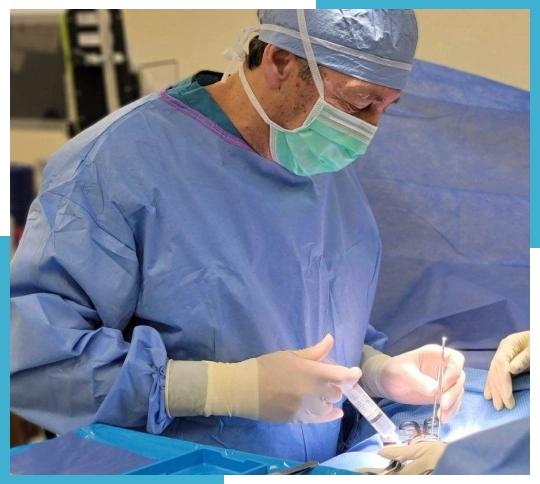A ventral hernia is a common medical condition that occurs when a part of the intestine or abdominal tissue pushes through a weak spot in the abdominal wall. This bulge is often visible and may cause discomfort or pain. While some cases are mild, severe forms of ventral hernias can lead to complications, such as strangulation of the intestines, requiring immediate surgical intervention. In this blog, we will explore the causes, ventral hernia symptoms, types of hernias, and the treatment options available, including surgery for ventral hernia.
What Causes Ventral Hernia?
Several factors contribute to the development of a ventral hernia. These include previous abdominal surgeries, where scar tissue weakens the muscles, excessive strain on the abdomen from heavy lifting, obesity, and even pregnancy. Aging can also weaken abdominal muscles, increasing the likelihood of hernia development. Chronic coughing, constipation, or even sneezing, which increases intra-abdominal pressure, can exacerbate the condition.
Types of Ventral Hernias
There are several types of ventral hernias, and understanding them is key to proper diagnosis and treatment. These include:
- Incisional Hernia: Occurs at the site of a previous surgery.
- Umbilical Hernia: Develops around the navel.
- Epigastric Hernia: Forms in the upper abdomen, between the navel and the breastbone.
Each type of ventral hernia requires specific approaches to treatment, depending on its size, location, and severity.
Common Ventral Hernia Symptoms
The ventral hernia symptoms often vary depending on the type and severity of the hernia. Here are the most common signs:
- A visible bulge in the abdomen that may increase when straining or coughing.
- Discomfort or sharp pain, especially during physical activities.
- Nausea or vomiting in severe cases, indicating possible intestinal obstruction.
- Constipation or difficulty passing gas, which may suggest a more serious complication.
Recognizing these ventral hernia symptoms early can help you seek timely medical attention.
Diagnosis of Ventral Hernia
Diagnosing a ventral hernia involves a physical examination where a doctor checks for a noticeable bulge in the abdomen. Sometimes, imaging tests like an ultrasound or a CT scan may be required to assess the hernia’s size and location. Proper diagnosis helps guide treatment decisions, particularly when planning surgery for ventral hernia.
When to Consider Ventral Hernia Repair
Not all ventral hernias require immediate surgery. In some cases, a doctor may recommend watchful waiting, especially for small, asymptomatic hernias. However, if the hernia causes significant pain, grows larger, or shows signs of strangulation (where the blood supply to the intestine is cut off), prompt ventral hernia repair is necessary. Ignoring these signs can lead to severe complications, requiring emergency intervention.
Treatment Options for Ventral Hernia
For many patients, ventral hernia repair is the best option to prevent complications. There are two main types of surgery:
- Open Surgery: A larger incision is made to access the hernia and repair the abdominal wall with sutures or mesh.
- Laparoscopic Surgery: A minimally invasive procedure where small incisions are made to insert a camera and instruments to repair the hernia with mesh.
Both options offer effective ventral hernia repair, but the choice depends on the hernia’s size, the patient’s health, and the surgeon’s expertise.
Risks of Untreated Ventral Hernias
If left untreated, ventral hernias can lead to severe complications such as incarceration or strangulation of the intestines, which cuts off the blood supply. This is a medical emergency that requires immediate surgery for ventral hernia to prevent life-threatening consequences. Ignoring ventral hernia symptoms like intense pain, nausea, or vomiting can worsen the condition.
Recovery After Ventral Hernia Surgery
Recovery after ventral hernia repair depends on the type of surgery performed. For laparoscopic surgery, patients can typically return home the same day, while open surgery may require a hospital stay. Physical activity should be limited for a few weeks to allow the abdomen to heal properly. Full recovery usually takes four to six weeks, but most patients can resume light activities within a few days.
Preventing Ventral Hernia Recurrence
After surgery for ventral hernia, there are steps you can take to reduce the risk of recurrence. These include maintaining a healthy weight, avoiding heavy lifting, and following post-surgery guidelines. Strengthening the abdominal muscles through gentle exercise after recovery can also help prevent future hernias.
FAQs About Ventral Hernia
- What is the difference between an incisional hernia and an umbilical hernia?
An incisional hernia occurs at the site of a previous surgery, while an umbilical hernia develops around the navel. Both are types of ventral hernias but differ in location and cause.
- How long does ventral hernia surgery take?
Surgery for ventral hernia typically lasts between one to two hours, depending on the size and complexity of the hernia. Laparoscopic procedures tend to be shorter.
- Can a ventral hernia heal on its own?
No, ventral hernias cannot heal on their own. They require medical attention, and in most cases, ventral hernia repair is necessary to prevent complications.
The Importance of Timely Ventral Hernia Repair
Ventral hernias are a common condition, but timely treatment can prevent severe complications. Understanding the causes, recognizing ventral hernia symptoms, and knowing when to seek surgery for ventral hernia are crucial for maintaining your health. Whether you opt for traditional open surgery or a minimally invasive laparoscopic approach, the key to a successful recovery lies in early intervention and proper post-operative care. If you’re experiencing any symptoms or have concerns about a possible hernia, consult with a medical professional to discuss your treatment options – Click here.




